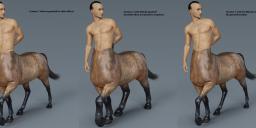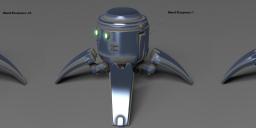[Released] Oso Blendy Two Layer Shader for Iray
 Oso3D
Posts: 15,039
Oso3D
Posts: 15,039
https://www.daz3d.com/oso-blendy-two-layer-shader-for-iray
VERY excited about this release!
I've been working on variations of this for a while, and the more I've learned about Iray and observed various products, the more call there was to create it.
Blendy adds another set of surface material parameters (like several of my other shaders), and then sets up a mask to control which is displayed. Furthermore, you can adjust the sharpness of the mask, and set which kind of blend mode applies. Blend mode is further divided into Values and Color; Values affects things like Metallicity and Bump, while Color affects things like Diffuse and Translucency color. Most of the time the default 'blend' is sufficient, but when you are doing something more complex, it is helpful to distinguish blend modes of color differently than other parameters.
And best yet, it's a Merchant Resource.
One of the driving factors behind this is the observation that a lot of maps for objects are excessive. For example, an object may have a separate Roughness and Metallicity map, not because the two maps are structured very differently, but simply because while the layout is the same, you want one layout of values (0 to 1) for Metallicity and a different set of values (.7 to .3) for Roughness. And in many cases you can't use the same map because you don't have enough control to shift the ranges.
With Blendy, you only need one map for these situations, and then you can set values as you want.
But if you want, you can combine different maps with the different layers. And the mask gives you freedom to alter the maps. You could have, say, a wood grain and glass layer, and then tailor the mask so that the layers are used for different style doors, or windows, and more.






Comments
Very nice,
I was thinking about to suggest you a product like this ;)
What I'm interesting in is skin fading, like a white guys which is changing into a black guy.
Starting e.g. on the head and fades slowly down. Or some blotchs with the new skin which increase.
I saw in your promo images that you have some skin transitions. Is there an slider to "move" the skin fade effect (the new skin wanders slowly down, from head to feat), or do I have to paint for each frame for such an skin transformation effect an own opacitiy map?
Does it also work with UV swapping? Using on e.g. as skin 1 a G8M skin and as the second a G8F skin?
The layers are controlled by a mask, so there isn't anything specific to move the transition.
It's a layer on the same surface, so it's all one UV map. If you want a radically different surface, your best bet is to use a geoshell (or maybe a decal, though those are very finicky).
I’m very interested in this. I almost posted a question two days ago asking if such a shader were available anywhere.
Can I ask for a bit more info?
1. Would you post screenshots showing all the available parameter “slots” in the shader, so we can get an idea of its capabilities? Either a text list of parameter names or a series of screenshots from DS is fine, whichever is more convenient for you.
2. What are the terms under which the shader may be used as a merchant resource?
3. Having to use one UV set is a reasonable limitation, one I can’t imagine would be possible to overcome in a shader. Are there any other technical limitations it would be good for users to understand up front?
Great product! I’ve been playing with it this morning, trying out some blood splatters, and after a few adjustments it’s working nicely.
The images don’t show in texture preview, similar to the diffuse overllay makeups, which is a pity, but not a major issue.
The materials load a whole lot faster that for an LIE preset, though on first impressions the shader appears to slow down the Iray render preview window. I shall have to test further, but I’m glad I purchased it, and the price was an absolute bargain.
Hi, what is the difference between Blendy and
https://www.daz3d.com/oso-janus-double-sided-shader-merchant-resource-for-iray
Would this product help blend the Alascanus men tail with any other character’s skin? I can’t lnk the discussions about using the tail on other characters (I’m on a mobile device which is not allowing me to do so) but I believe you might have participated in the discussion thread.
Inkubo:
Attaching a sample of parameter slots. The full list of second layer parameters:
Metallicity 2, Base Color 2, Translucency Weight 2, Translucency Color 2, Glossy Layered Weight 2, Glossy Color 2, Glossy Reflectivity 2, Refraction Weight 2, Refraction Color 2, Refraction Roughness 2, Base Bump 2, Normal Map 2, Top Coat Weight 2, Top Coat IOR 2, Top Coat Roughness 2, Top Coat Color 2, Top Coat Bump 2, Emission Color 2, Luminance 2, Displacement Strength 2, Horizontal Tiles 2, Horizontal Offset 2, Vertical Tiles 2, Vertical Offset 2.
You can find these parameters easily by entering ' 2' into the surface pane's filter.
2:
Merchant license terms:
'Oso Blendy can be included in any product sold in the Daz store. It would be nice to be mentioned, but not required.
The only other restriction is that if you are making a Merchant Resource, you must make it very clear that Oso Blendy is not included in your merchant license.'
3:
Technical limits for any shader mixer product are that the shader is 'frozen.' Which means all the parameters are visible, even if you aren't using them. Which is a little annoying but inescapable. Also Top Coat is fresnel only (again, because of the freezing thing). I also cut a few parameters for efficiency, like backscatter, thin film, and metallic flakes. I really like thin film and metallic flakes, but had to balance function vs 'aaaah there are so many parameters to wade through'
Redz: Yeah, it's a limitation of custom shaders. And sometimes regular shaders, as you noted. Custom shaders are often a little slower to render than standard shaders, but the difference isn't normally great and it's a bit of a complex subject. For example, Blendy can cut down on the number of image maps needed, which may mean the difference between CPU and GPU rendering. It also obviates the need for geoshells in some cases, which a modest savings there.
Artini: Janus has two layers, one on each side of a surface. Blendy has two layers arranged normally, controlled by a mask and can be blended in various ways.
They are both double layer shaders, but the details are a lot different, heh. (And Oso Master Shader is _also_ a two layer shader, but doesn't have multiple blend types and is more focused on random distribution of the two layers)
This looks like another grand product - except that it highlighted that I may need new spectacles: I read it as "Bendy" shaders the first couple of times I looked at it and wondered what kind of bending a shader was going to do!
It's waiting in my cart (and qualifying me for a nice GC discount too) while I cogitate what else I might like today.
Edit: to fix typos - can I upgrade my fingers along with my specs, I wonder?...
Grabbed this one right away and am looking forward to using it! Looks to be most useful!
This may come in handy for those that want to make their own characters with Vitiligo!
Bought instantly! Looks intriguing. Esp for doing things like face masks and effects!
Thank you, @Oso3D! This sounds just like what I was wishing for. Buying it now.
Side note: If you want very distinctly different specular effects, the easiest/best way in Blendy to do this is with Top Coat.
There's also a weird thing about translucency; if the first layer has 0 translucency weight and the second layer has translucency, you will want to set Translucency Color to black to properly shut it down.
I posted the following problem description in the DAZ Studio Discussion forum and was advised to take a look at this thread (and product) for a possibe explanation/solution. I don't see any mention of Cutout Opacity in this thread, however.
I'm not entirely sure what that has to do with Blendy, but...
Any time you use Cutout Opacity of ANY kind on an object, it gets handled as if Thin Shell is set to On, and all volume effects (SSS/transmitted color) are ignored.
As I said, I was directed here by someone in that other thread - apparently the thinking was that this product might help. Sorry to add confusion (I'm still confused too). I'm just looking for a possible solution but it seems there is none.
The problem you run into is that you want partial volume effects, and Iray doesn't really do that easily.
Options:
Dump SSS entirely; set everything to Thin Shell On, adjust parameters accordingly. Instead of using SSS you can use Refraction Roughness, which can help create a somewhat similar effect (Blendy has Refraction roughness 1 and 2, which helps).
Don't use Cutout, use Refraction. Set Refraction Index to 1; with Refraction Index 1 and Weight 1, the surface is invisible. (Except you then have to deal with SSS, so, see previous step)
This product can help, but the underlying issue is that SSS is either being switched off entirely, or (if you make part of the surface transparent) applying where you don't want.
Thanks, I'll try those suggestions (if I understand them correctly). I never imagined that making a small area of skin transparent (to see an organ prop within, for example) could be such a problem. Shows how much I still have to learn about surfaces.
I have this in my cart and I hope I'll have some time to play with this product during the weekend. I know it'll open so many possibilities, just have to take a moment to wrap my head around it. Regardless, I'm excited :).
Gigi: I am really excited to see what people do with it!
Marble: The thing to remember is that an object is mostly defined as this paperthin surface that does 'stuff' to light. Then there's another set of things that treats the object as a solid and defines how light goes through it. These are two distinct and interacting components. So it's not hard to poke holes in the surface or get it to do weird things, but the renderer is a bit more fussy about how to manage solid stuff.
@Oso3D, Interesting product. Can you set different UV tile settings for each layer so you could break up a repeating pattern? This would be great for ground cover. Also how does the blended texture hold up if you do an FBX export. Thanks in advance for the help.
I think I wasn't clear why I sent @marble here. His end goal is to create custom zombie type characters. While Blendy may not help at all with transparency, I was thinking that if he wanted to have some "raw meat" sections of skin while the rest of it looked more normal it might help achieve that effect. Sure it won't cut away the geometry of the character, but with some clever mask and texture use, I could see it blending rotting and healthy flesh.
Oh definitely, Jonny. And what's nice is that if you have two different sets of maps, you can quickly and easily create multiple masks to reveal different bits as you want. So, like, have Regular Skin/Zombie Skin, then a whole bunch of partial material presets to swap out blend masks.
rich: You can tile the layers independently, sure!
As for export, that won't work; this is a special Iray shader written with Daz' Shader Mixer.
Thanks a lot for the explanation. I were totally lost in what to expect from your different shaders.
The link to the pdf from the readme page gives a forbidden page, any chance of being able to access the pdf.
From Oso you can expect quality and unique results / effects that you won't get from very many other vendors. :)
I get what you meant, my fanboy just showed through there for a second.
Maybe it was me that wasn't clear in what I wanted to do but thank you both for your suggestions. It wasn't so much a zombie character as any character with an area of transparent skin through which I could show internal organs (props). Maybe medical, maybe horror, maybe anatomy class for artists - if you get my drift.
I was inspired to try this...
This is Pete + Markus Zombie (which is G3), with Pete and Wither morphs.
Plus a few aging morphs for lulz.
It needs fixing properly, but if you really want it "now" then capture the url it goes to and replace the bit that says "group" with "public" and the part that says "staging" with "index" - worked for me (I've had this problem with a few products where I wanted to check out the user guide before committing to a purchase)
PS: I checked out so now I just need time to play with this latest purchase... That Pete/Markus pic is truly hideous, Will! (That's meant to be praise, by the way)
You've become an Iray surface master! Just got this one along with your dual surface one a few weeks back. Glad you're bringing new capability to surfaces.
Hey there! N00b here, so a lot of the discussion so far is a bit over my head. Did I understand this correctly, this product allows me to blend any two iray shaders I have on the same surface? Cheers!